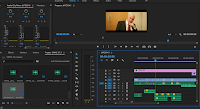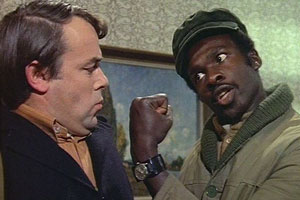Objectives:
- Who is 'the author' in film & TV? And how do we define the role and function of 'the author'?
- The 'auteur' theory: Advantages, limitations and alternatives.
- Authorship in TV: who has the creative control?
Production hierarchy:
Executive producer - primarily responsible for financial control but may have creative input, particularly in editing and post-production stages.
Producer - primarily supervises production logistics and budget in tandem with the director. May originate project and usually hires writer(s) and director and will be involved in casting.
Director - primarily responsible for creative vision and creative decisions in collaboration with creative team.
Writer - responsible for authoring original script or adapting existing literary material.
(This is not set in stone and can vary for different films and TV-productions. Especially who has the most creative input of the director and the writer.)
Changing face of creative control:
Cinema
- Silent era (1900-1927): the director (Griffiths, Chaplin)
- Studio era (1930-1960s): The producer (Freed, Selznick)
- 'New wave' (1960s-1980s): directors and writer-directors
Television
- 'Golden Age' (1950s-1960s): producers & writers
- ' New Wave' (1960s-1970s): producers and directors
- 'Writers' (1980s-Present): Producer-writers and showrunners
Origins of the auteur theory:
- Cahiers Du Cinema (radical French film journal) - in 1954, critic (and later on director) Francois Truffaut writes a polemic in which he coins the phrase 'la politique des auteurs' (The Authors Policy).
- Reaction against 'bland' commercial cinema where the director largely regarded as 'chief technician' who just shot the script (matteur-en-scene).
- Truffaut and fellow critics wanted instead a cinema d'auteurs: directors (and director-writers) who expressed an individualistic world view and use mise en scene.
- This 'auteur cinema' expressed in group-breaking French New Wave films of late 50s-early 60s.
Definition of 'auteur':
The auteur theory was championed in the US by film critic Andrew Sarris in his essay 'Notes On The Auteur Theory In 1962'.
Sarris states three key criteria that define an auteur:
- The technical competence of the director (ability to organise a film with clarity and coherence).
- The distinguishable personality of the director (recurring signature style).
- Interior meaning (the cinematic art created from tension between a director's personality and his material).
A director has to have made a minimum of 3 films to be considered an auteur (safely half u dusin films).

Sarris meant that there are no 'bad' films: only bad directors.
Even the worst film of an 'auteur' director can be rescued from anonymity.
Issues with auteur theory:
- Doesn't recognise collaborative nature of film and television, and contribution of writers and technicians.
- What directors were attempting to portray was secondary to the actual visualization on screen.
- Only a few rare directors have 'final cut'.
- Genre theory as an alternative to auteur theory.
Genre theory vs auteur theory:
Genre theory focuses on:
- Generic similarities
- How texts are determined by historical/social/political contexts
- How texts emerge as commercial products from an industry
Auteur theory focuses on:
- Individual stylistic features
- How texts are determined by directors' creativity
- How texts emerge as part of a director's body of work
A writer's medium?
- As a new art form in the 1950s, TV was heavily reliant on dialogue-led stage and literary adaptations and studio based genre productions (sitcoms, soaps, sci-fi)
- Writers, producer and directors came principally from radio and theater.
- The core model became the close writer-producer working relationship, with directors largely 'hired guns'.
What are the TV auteurs?
Stephen Poliakoff

- Began writing career in theater; award-winning playwright.
- Commissioned by BBC and others to write several TV films, working with established producers and directors.
- Made directing debut with Hidden City (1988, Film4)
- Since 1988 he has written and directed over a dozen features, TV movies and mini-series, mostly for the BBC.
- Considered pre-eminent BBC writer-director and allowed to exercise control over casting and final cut.
Technical competence:
Although not a formally-trained visual director, Poliakoff is widely considered to have evolved a degree of technical competence.
'Competence' is seen as control:
a) Framing (shot)
b) Camera movement
c) Editing in order to convey narrative
Personal style:

Recurring visual motifs
- Long tracking shots
- Deep focus
- Clash between modernity and traditional
- Slow-pace
Interior meaning:

- History, memory, ghost of past
- Secret
- Social class
- Themes of power and control
//All images from Google.com\\
 When working on the clips I couldn't really do much to change it as I either didn't have more takes (due to very limited time on set) or there were acting- or continuity mistakes in the other cuts that I had.)
When working on the clips I couldn't really do much to change it as I either didn't have more takes (due to very limited time on set) or there were acting- or continuity mistakes in the other cuts that I had.) Today I went back to Simon to show him what I had changed. He still wanted some more ambient sound, especially in the police office, which I slightly disagree with as I find it too distracting/disturbing and it also feels a bit unrealistic/fake.
Today I went back to Simon to show him what I had changed. He still wanted some more ambient sound, especially in the police office, which I slightly disagree with as I find it too distracting/disturbing and it also feels a bit unrealistic/fake.

















































